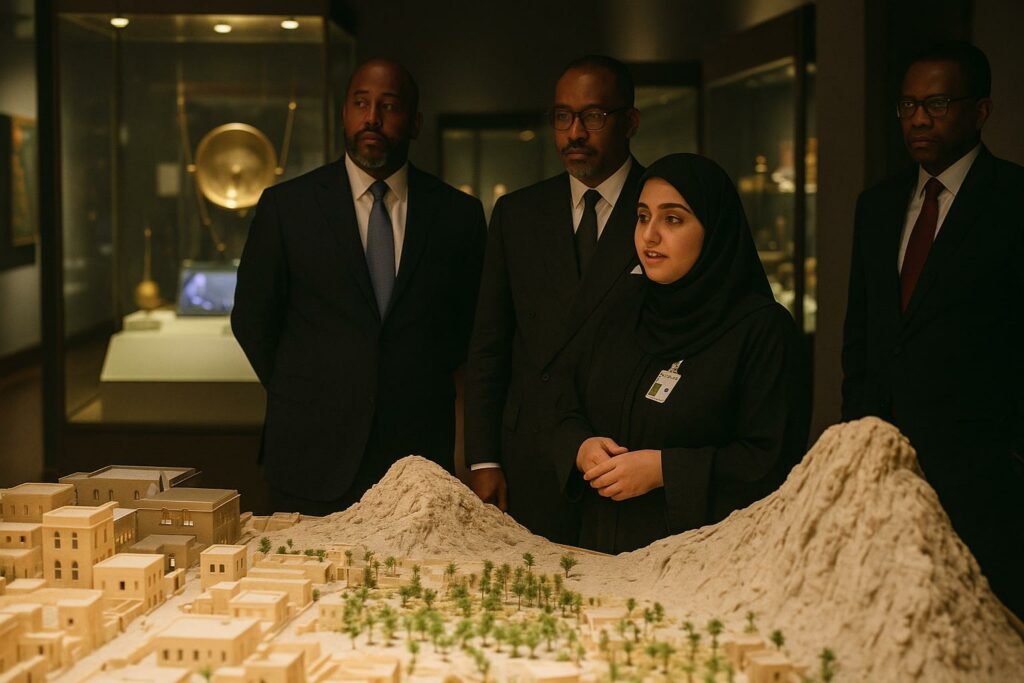Omani Cultural Diplomacy in Focus
The soft morning light in old Muscat lent a solemn hue to the wide forecourt of the National Museum as Denis Christel Sassou Nguesso, Minister of International Cooperation and Promotion of Public-Private Partnerships of the Republic of Congo, walked past the ceremonial guards on 15 September. Standing barely four hundred metres from Al-Alam Palace and framed by the minaret of Ali Musa mosque, the institution has become a nerve centre of the Sultanate’s cultural diplomacy since its public opening in 2016. By choosing this venue as his first stop in the Sultanate, the Congolese minister signalled that culture, memory and identity remain pivotal vectors of international relations.
A Living Chronicle of the Sultanate
The National Museum’s twelve permanent galleries unfold more than 7 000 artefacts across 4 000 square metres, from prehistoric flint tools to the gilded ephemera of the oil era. In the wing entitled “Oman and the World”, the minister paused before shards of Ming porcelain and gold coins salvaged from a vessel believed to have belonged to Vasco da Gama’s fleet, wrecked off the Omani coast in 1503. “These pieces remind us that the Indian Ocean has always been a highway of ideas and commodities,” he commented, according to a member of his delegation. The remark echoed the museum’s curatorial ambition: to narrate Oman’s interactions with Africa, Asia and Europe through tangible evidence rather than abstract timelines.
Shared Commitment to Heritage Preservation
Heritage conservation is a policy priority shared by Brazzaville and Muscat. Congo-Brazzaville has multiplied initiatives to catalogue traditional kingdoms’ regalia and to restore colonial-era architecture along the Congo River. Oman, for its part, has invested heavily in museum infrastructure and digitisation programmes recognised by UNESCO. During his walkthrough, Denis Christel Sassou Nguesso exchanged views with Omani curators on conservation techniques adapted to tropical humidity and desert aridity alike, underscoring the universality of preservation challenges. Such technical dialogue, though discreet, nourishes the prospect of exchanges between archivists, archaeologists and restorers from both nations.
Reinforcing Bilateral Cooperation Frameworks
While the visit carried an evident symbolic charge, it also inserted itself into a broader diplomatic ballet. Brazzaville and Muscat maintain cordial relations grounded in non-aligned multilateralism and complementary economic interests. According to officials close to the file, negotiations are under way for a memorandum of understanding covering museum studies scholarships and travelling exhibitions. The minister’s presence therefore acted as a gentle accelerator, providing political imprimatur to dossiers already circulating among senior civil servants. In Muscat, observers noted that the visit followed a recent rotation of ambassadors, a sign that both capitals wish to tighten coordination on cultural as well as strategic matters.
Economic and Public-Private Horizons
The portfolio entrusted to Denis Christel Sassou Nguesso includes the delicate task of mobilising private capital for public goals. Heritage, increasingly, is seen as investible infrastructure capable of generating revenue through tourism, merchandising and intellectual-property licensing. The National Museum’s business model—concessions for guided tours, a design shop showcasing Omani artisans, and partnership agreements with luxury hotels—offers a template the Congo may adapt for sites such as the future Pointe-Noire Maritime Museum. During the visit, the minister invited Omani executives specialising in museum management to attend an investment forum in Brazzaville later this year, a proposal welcomed by interlocutors as “a natural extension of today’s dialogue”.
Legal and Protocol Considerations
From a legal perspective, cultural cooperation between states rests on bilateral agreements aligned with the 1970 UNESCO Convention on the illicit trafficking of cultural property. Both Oman and the Republic of Congo are signatories, which facilitates the loan of artefacts and the circulation of expertise. Diplomats present in Muscat highlighted that respecting intellectual property, acknowledging provenance and ensuring appropriate insurance coverage remain prerequisites for any forthcoming exhibition swap. By reiterating these safeguards, the minister positioned Brazzaville as a reliable partner adhering to international norms, thereby enhancing the country’s soft-power footprint without courting controversy.
A Symbolic Walk, A Strategic Step
As the delegation exited onto the sun-drenched plaza, cameras captured a final handshake between Denis Christel Sassou Nguesso and the museum’s acting director. The moment distilled the essence of the visit: a careful blend of protocol and projection, where appreciation of antique daggers and seafaring charts dovetails with twenty-first-century ambitions. For Congo-Brazzaville, engaging with Oman’s flagship museum is less about a single day in September than about weaving durable alliances in the cultural and economic fabrics of the Indian Ocean arena. In the words of a senior Congolese diplomat, “heritage is memory, but it is also foresight”.

